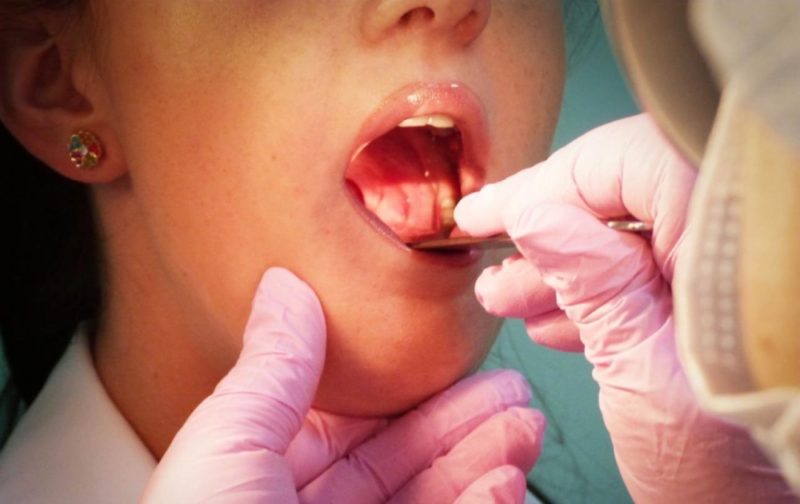Chronic tonsillitis is a long-lasting inflammatory process in the tonsils (glands), the main function of which is to protect the body from infections. But, as a rule, it is they who are the first to get in the way of infectious attacks.
Material Content:
Causes of chronic tonsillitis
The described pathology needs treatment, but for this it is important to identify the cause of the disease.
Most often, an infection mixed with aerobic and anaerobic bacteria, which can also be in the form of a biofilm, becomes a provocateur. A feature of the disease is the possibility of hypertrophy of the tonsils (usually at a younger age).
Chronic tonsillitis can also begin to develop due to the presence of bacteria (mainly streptococci). Their development on tonsils in large quantities causes the formation of inflammation - tonsillitis. This happens due to the activity of streptococci, which secrete special proteins. As a result, symptoms appear in the form of edema, fever and abnormalities in the functioning of cells.
Symptoms and clinical presentation
Finding out if you have chronic tonsillitis on your own is almost impossible. To justify (refute) the diagnosis, a visit to a doctor of narrow specialization (otolaryngologist) is necessary. However, the main symptoms in which it is worth thinking about a visit to a specialist, you need to know.
Chronic tonsillitis in adults usually does not give serious symptoms - the throat only hurts from time to time, there may be slight discomfort when swallowing and the lymph nodes may become denser.
In addition to relapsing tonsils, the following symptoms of chronic tonsillitis exist:
- periodic, fairly frequent pain, creating discomfort in the throat;
- a musty or purulent odor emanating from the oral cavity;
- problems with swallowing not only solid food, but also saliva are common;
- feeling aches in bones and joints;
- causeless fever;
- impotence;
- constant feeling of lack of sleep;
- nervous excitement;
- weakened immunity;
- a feeling of a foreign object in the throat that the patient unsuccessfully tries to cough;
- a slight increase in body temperature, most often with the onset of night;
- the presence of purulent congestion;
- "Lump" in the throat, which can not be pushed either by coughing or by liquid.
During the examination, the doctor usually sees congestive palatine arches, enlarged cervical lymph nodes, fluid purulent discharge, or hard, offensive deposits inside the tonsils.
Inflammation of tonsils with a chronic nature leads to the transformation of their structure. As a result of the disease, they become large, swollen and overgrown. In addition, the infection spreads deep into the tissues of the glands and their blood vessels, into the kidneys, heart, or joints.
This situation can be very dangerous for a person, because it causes serious diseases of these organs, for example:
- arthritis;
- glomerulonephritis;
- rheumatism.
Chronic tonsillitis in a child is more pronounced. Often it is accompanied by a sharp increase in temperature within 39 degrees, as well as attacks of suffocation.
Diagnostic Methods
When diagnosing an ailment, it is necessary to identify its stage, type and form. It cannot be done independently, therefore it is worth contacting a clinic with such specialists as an otorhinolaryngologist or an infectious disease specialist. It is they who, based on the symptoms and medical history, will prescribe the necessary diagnostic measures.
Most often, the following studies are carried out:
- Examination of the throat, tonsils and areas located next to them, as well as lymph nodes to identify typical symptoms.
- Complete blood count to assess the severity of the inflammation process.
- Biochemistry (blood test) to identify substances inherent in rheumatic processes.
- Tonsils with tonsils for bacterial studies to determine the sensitivity of bacteria to antibiotics.
When examining the larynx or pharyngoscopy, the doctor draws attention to the following signs characteristic of this disease:
- friability of tonsils;
- the presence of scars;
- the presence of traffic jams;
- pus formation;
- an increase in the tonsils.
In addition, frequent diseases of the patient with tonsillitis will previously indicate the presence of chronic tonsillitis.
It is important to consult a doctor in a timely manner in order to start therapeutic measures as soon as possible, not start a pathology and not get fatal complications.
Treatment in adults and children
Treatment of chronic tonsillitis is prescribed by the doctor, depending on the stage and form of the disease. Based on the general condition of the body, the disease is treated with medication or with surgical intervention.
Chronic tonsillitis, the treatment of which in children practically does not differ from adult therapy, is especially dangerous for expectant mothers. Therefore, women planning a pregnancy should cure the disease in advance.
Drug therapy
Drug therapy consists in taking the following medications:
- Antibiotics. Usually prescribed in case of exacerbation of the pathological process. Most often it is penicillin or cephalosporin. In addition, at elevated temperatures, the doctor prescribes anti-inflammatory drugs.
- Painkillers. For severe sore throats, ibuprofen is prescribed.With weak pain, taking them is irrational.
- Antihistamines. Reduce swelling of the glands, can alleviate the general condition.
- Immunostimulating agents and vitamins. They increase immunity and help the body cope with the disease faster.
In addition, the doctor prescribes home treatment with methods such as:
- gargling, including antiseptic drugs, for example, furatsilinom;
- washing the gaps to combat traffic jams.
Gargling helps to normalize the microflora, reducing the number of pathogenic bacteria. The most common drugs for the procedure:
- Furatsilin.
- Miramistin.
- Iodinol.
During remissions, physiotherapy can also be prescribed.
Folk remedies
Well proven and some methods of alternative medicine:
- In chronic tonsillitis, sea buckthorn or fir oil has a cardinal help. They are applied with a cotton pad to the tonsils for a minimum of 7, and a maximum of 15 days.
- Aloe is known to everyone for its medicinal properties, it can also be successfully used for this pathology. For this, a simple recipe is suitable - combine aloe juice with honey in the proportions 1: 1, add half of the water (if you wish, you can add a few drops of onion juice) and lubricate the resulting mixture of tonsils daily for at least 10 days. At the third and fourth week, the procedure is recommended to be carried out every other day.
- An excellent folk remedy for tonsillitis is eating as much ginger and turmeric as possible, which not only strengthen the immune system, but also affect bacteria and viruses.
- You can not do without broths, which in folk medicine occupy a leading position. With a blast of eucalyptus leaves, chamomile flowers and walnut shells, inhalations can also be made and tonsils can also be lubricated. This contributes to the speedy disposal of corks and pus.
Important! Before resorting to treatment with the help of folk remedies, it is necessary to consult a doctor.
Surgical intervention
Treatment of tonsils, consisting of rinses and analgesic effects, in the case of chronic inflammation is of little use. The same applies to antibiotic therapy, which gives an improvement in acute inflammation.
The only effective treatment for chronic inflammation is tonsil excision. The procedure is performed under general or local anesthesia.
Sore tonsils are unconditionally removed in such conditions:
- peripapillary abscesses;
- a large increase in the glands;
- recurrent disease, for example, with purulent inflammation;
- suspected cancer.
After removal of the tonsils, the patient should remain in the hospital for several days. A liquid diet is recommended, as well as painkillers.
Modern experts can also offer one of the new methods of treatment, for example, partial evaporation of tonsils with a laser. This prevents the progression of the disease and at the same time preserves the function of the glands. Modern laser methods give very high efficiency, are performed under local anesthesia and are safe, preventing severe postoperative bleeding.
Possible complications
With a long course of chronic tonsillitis, pathogenic bacteria can spread throughout the circulatory system, affecting all organs, which can trigger the appearance of pathological conditions.
Complications of inflammation of the tonsils are divided into two types:
- Phlegmonous tonsillitis belongs to the local.
- A common complication is rheumatism, neuritis, myocarditis, nephritis, and lupus erythematosus.
In many cases, complications require combined treatment with antibiotic therapy, and sometimes surgical intervention, and, accordingly, hospitalization.
Is chronic tonsillitis contagious
Chronic tonsillitis is dangerous for others only at the stage of exacerbation.
Whether a person in contact with the patient is infected or not depends on the level of his immune system. In everyday life, we often encounter pathogenic bacteria, if the defenses of our immunity block them in a timely manner, infection does not occur.
The disease is transmitted in the following ways:
- through the air when the patient sneezes or coughs;
- contact if you touch objects that are used by a person with such a disease. One common example is drinking from the same mug with a carrier of the ailment.
Prevention of exacerbation of the disease
Prevention of chronic tonsillitis is the best way to maintain your health.
It consists in observing the following rules:
- a visit to the otolaryngologist at least once a year (preferably every six months) for the rehabilitation of tonsils;
- the exclusion of spicy foods and chilled drinks from the diet.
As well as a preventive method, hardening is considered.
Compliance with preventive measures and timely contact a doctor for the appointment of adequate therapy is the key to healthy tonsils.





















